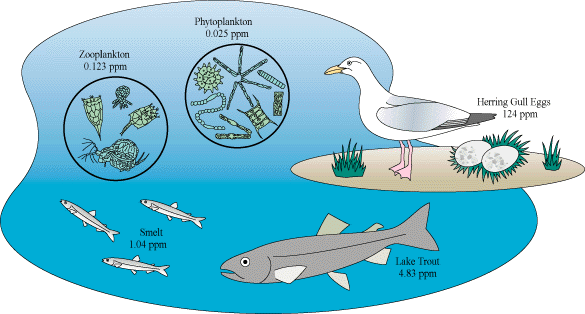Our pick for the best single book for the non-scientist on this subject is Our Stolen Future, by Theo Colborn, Dianne Dumanoski and John Peterson Myers (Penguin Books, 1996), which covers what is and is not known about the effects of toxic substances on endocrine and nervous system disruption. For further information go to:
For an action campaign focused on this issue, go to:
Joe Thornton, author of Pandora's Poison: Chlorine, Health and a New Environmental Strategy, argues all chlorinated plastics, right down to plastic bags, should be banned. (ENS review 6/8/00).
Persistent Organic Chemicals such as PCBs bioaccumulate. This diagram shows the degree of concentration in each level of the Great Lakes aquatic food chain for PCBs (in parts per million, ppm). The highest levels are reached in the eggs of fish-eating birds such as herring gulls.
This graphic and the text above and below are from Exploring the Great Lakes, an interactive CD-ROM produced by Purdue University and USEPA Region 5, and available for free to educators, local governments and non-profit groups in the Great Lakes region. The CD includes a powerful Great Lakes Atlas providing comprehensive data on water flow, quality, and ecology. Contact: Local Government Environmental Assistance Network (LGEAN) by clicking on the link, e-mail LGEAN at lgean@icma.org, call toll-free at 877-865-4326, or call Larry Brail of EPA at 312-886-7474.
The nutrients necessary for plant growth (e.g., nitrogen and phosphorus) are found at very low concentrations in most natural waters. In order to obtain sufficient quantities for growth, phytoplankton must collect these chemical elements from a relatively large volume of water.
In the process of collecting nutrients, phytoplankton also collect certain human-made chemicals, such as some persistent pesticides. These may be present in the water at concentrations so low that they cannot be measured even by very sensitive instruments. The chemicals, however, biologically accumulate (bioaccumulate) in the organism and become concentrated at levels that are much higher in the living cells than in the open water. This is especially true for persistent chemicals - substances that do not break down readily in the environment - like DDT and PCBs that are stored in fatty tissues.
The small fish and zooplankton eat vast quantities of phytoplankton. In doing so, any toxic chemicals accumulated by the phytoplankton are further concentrated in the bodies of the animals that eat them. This is repeated at each step in the food chain. This process of increasing concentration through the food chain is known as biomagnification.
The top predators at the end of a long food chain, such as lake trout, large salmon and fish-eating gulls, may accumulate concentrations of a toxic chemical high enough to cause serious deformities or death even though the concentration of the chemical in the open water is extremely low. The concentration of some chemicals in the fatty tissues of top predators can be millions of times higher than the concentration in the open water.
The study of PCBs has contributed significantly to our understanding of bioaccumulation. Although production of PCBs has been banned in the U.S. for some years, many products containing PCBs such as electrical and building materials are widely used and commonly discarded or incinerated as waste. Substantial dangers therefore continue to be presented by release of PCBs into the environment. For more see EPA Region 2's factsheet, and the PCB Resource page of the International POPs Elimination Network.
The Arctic Monitoring and Assessment Program said in a Sept. 24, 2002 report that mercury levels in some Arctic indigenous people are high enough to affect children's development, and PCBs build up in the food chain, especially in fatty tissue like blubber -- key nutrition for polar bears and the Inuit. As a result polar bears and Inuit suffer subtle effects on the immune system, brain development and reproduction.

